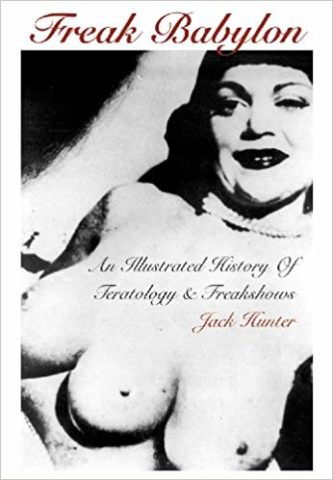 By JACK HUNTER (Creation; 2005/10)
By JACK HUNTER (Creation; 2005/10)
A heavily illustrated book in the mold of Fredrick Drimmer’s VERY SPECIAL PEOPLE and Daniel P. Mannix’s FREAKS: WE WHO ARE NOT AS OTHERS, though not as satisfying as either. Clearly, FREAK BABYLON was a quickie in every sense of the word: it runs a scant 114 heavily illustrated pages, with much of the content taken from Jack Hunter’s earlier book INSIDE TERADOME, as well as lengthy appendices consisting of texts readily available elsewhere, including Sir Frederick Treves’ 1923 essay “The Elephant Man” and Tod Robbins’ classic tale “Spurs” (from which Tod Browning’s legendary FREAKS was adapted).
I’m always up for a freak book, as I’m sure are most of us. One of this book’s major themes is mankind’s perpetual fascination with human oddities, be they naturally born or manmade. Author Jack Hunter provides a historical overview of freak worship in the 19th and (early) 20th Centuries, when circuses and sideshows began cropping up with so-called Freak Shows as their main attraction. From there followed the advent of cinema, whose earliest incarnations were, Hunter argues, directly tied to the sideshow in the distortions of the human body created by Georges Melies and his successors, a trend that culminated in the aforementioned FREAKS in 1932 (all this information, FYI, is far more thoroughly and satisfyingly delivered in Hunter’s earlier tome INSIDE TERADOME).
Hunter includes info on the hideous experiments carried out by Dr Joseph Mengele in Auschwitz during WWII, as well as the human mutations created by the bombing of Hiroshima and the next logical step in freakology: cyborg technology, which apparently heralds a new-fangled freak “not made by nature, or drugs, but by computer science. Not a freak of deformity, but of conformity.”
Also featured are brief mini-bios of such famous freaks as the legless Johnny Eckhardt, Prince Randian the “living torso” and the most famous freak of them all, John Merrick the Elephant Man (all of whom are better treated in the abovementioned Daniel P. Mannix and Frederick Drimmer volumes), complete with many revealing photos. So FREAK BABYLON is worthwhile, but it’s far from the most comprehensive book on the subject.
